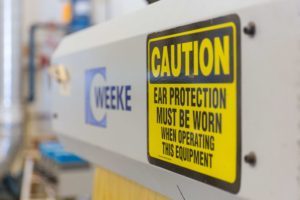 Hearing protection devices are designed to prevent noise-induced hearing loss in the workplace and at home. For workplace safety, a hearing protector is required to reduce the ambient noise (surrounding noise) to 90 dBA and lower. However, if the employee has a threshold shift from their determined baseline, hearing protection is then required to lower the ambient noise to 85 dBA and lower. Employees can voluntarily use hearing protectors if the ambient noise is below the 85 dBA.
Hearing protection devices are designed to prevent noise-induced hearing loss in the workplace and at home. For workplace safety, a hearing protector is required to reduce the ambient noise (surrounding noise) to 90 dBA and lower. However, if the employee has a threshold shift from their determined baseline, hearing protection is then required to lower the ambient noise to 85 dBA and lower. Employees can voluntarily use hearing protectors if the ambient noise is below the 85 dBA.
So, how do I know how much a hearing protector will reduce the noise before it enters my ear?
An important factor in choosing a hearing protector is how much noise it will block out from the ears. The manufacturer has already calculated the attenuation information (how much noise is blocked). This number is identified on the hearing device or the device’s package. Typically, the manufacturer will use the acronym “NRR” (Noise Reduction Rating) combined with a number that together will look like “NRR 25.” Using NRR 25 as an example, the manufacturer is telling you the hearing protection device, based on laboratory conditions, will reduce the ambient noise the employee is exposed to by 25 dBA. In this example, if the noise in the work area is 90 dBA, the ambient noise will be reduced down to 65 dBA with these protectors. However, the NRR 25 is not realistic. Why is that?
The whole concept of hearing protection for safety at work is to have a secure fit between the plug/muff around the ear or against the ear canal to prevent noise leakage to the inner ear. During work, the hearing protector device can work itself out of position, displacing the plug from its proper position and reducing the effectiveness of the protector

Example 1: By chewing or talking, an employee’s jaw motions push the hearing protectors from the ideal position.
Example 2: During work, the employee’s perspiration affects the ear device position and requires readjustment.
Example 3: The hearing protector is not inserted correctly at first, negating a “tight fit” from the start.
If the NRR rating on the package is artificially too high, how much do you need to reduce the NRR rating to determine the correct level of hearing protection for industrial safety?
To calculate the new NRR rating, simply subtract 7 dB from the protector’s NRR rating. If the listed NRR is 25, the realistic rating is 18 dBA. Many people feel that 18 NRR is still too high because of the variables involved that negate a good tight fit. OSHA can apply a 50 percent “derating” for some applications, giving credit only to half of the labeled protection when comparing the use of hearing protection devices to noise controls.
In summary, NRR is used by OSHA to determine hearing protection effectiveness. To obtain a more realistic rating, subtract 7 dB from the NRR number on the package or protector. Many companies will reduce the NRR rating more than 7 dB to be on the safe side. EPA manages the testing and labeling process of hearing protectors; OSHA determines how to apply the EPA labels in practice.
If you are concerned about industrial health and safety in your workplace and would like assistance or support, contact our Minnesota safety consultants. We offer safety audits, safety risk assessments, OSHA training, and many custom programs. Call us today at 763-417-9599.
 763.417.9599
763.417.9599
